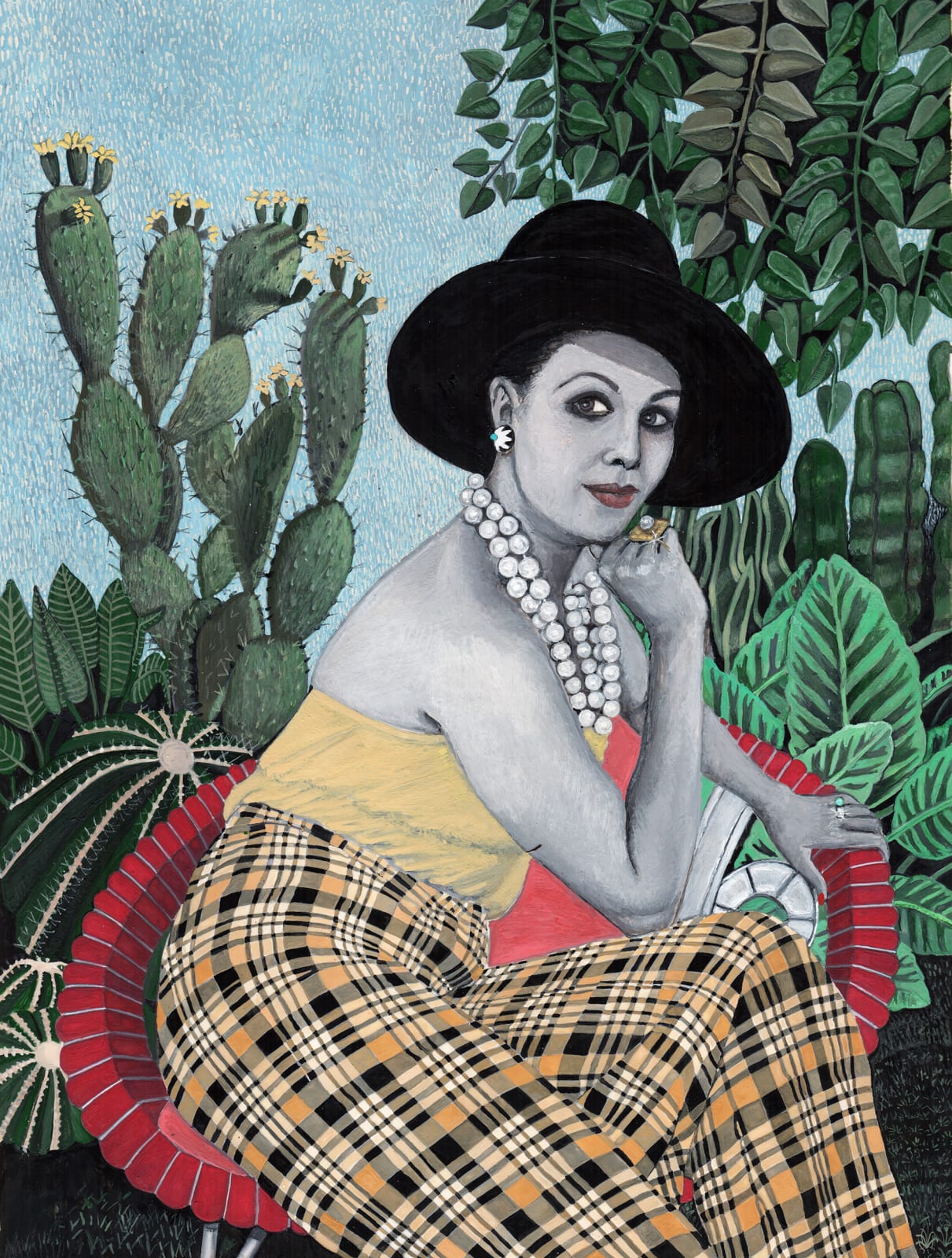Soheila Sokhanvari
The Dancing Queen (Portrait of Jamileh) , 2019
Egg tempera on calf vellum
Painting Size:
31.6 x 23.9 cm
12 1/2 x 9 3/8 in
Framed Size:
70 x 50 cm
27 1/2 x 19 3/4 in
31.6 x 23.9 cm
12 1/2 x 9 3/8 in
Framed Size:
70 x 50 cm
27 1/2 x 19 3/4 in
Copyright The Artist
Dancing Queen (Portrait of Jamileh) 2019 The title here is named after the song by the Swedish group ABBA, released in 1976. The song is a catchy and euphoric beat...
Dancing Queen (Portrait of Jamileh) 2019
The title here is named after the song by the Swedish group ABBA, released in 1976. The song is a catchy and euphoric beat that encapsulates the carefree bliss of youth and makes a great backdrop for the story of Iran’s most famous female dancer.
Fatemeh Sadeghi ( 26 October 1946), better known by her stage name Jamileh, is an Iranian actor, cabaret performer and dancer. Born in Tehran to a poor family, her father Rajab Vâksi, was a walnut seller who later became an actor in the local theatre scene in Tehran. Her uncle, Morshed Nasrollâh, was a musician and a travelling poet/performer. She learnt her dancing from her father and often performed with him.Her first marriage was to a singer of the traditional genre of Persian musical comedy theatre, which was short lived. She then married Mohammad Arbâb, the owner of the cabaret that she performed in and soon after she earned enough money to open her own cabaret, Lidu in Tehran. Her marriage to Arbâb lasted from late 1960’s until his death in 1973.
Much like other Iranian entertainers of the time, Jamileh’s dancing career provided her the opportunity to enter Iranian cinema, which would eventually lead her to national and international fame. She mainly played dance-related roles in more than 25 films. She was reportedly the highest-paid cabaret actor of Iranian origin in 1974 and performed for many famous guests including Henry Kissinger and the Greek tycoon Aristotle Onassis in Tehran, Iran in 1972. Like Josephine Baker, she was a powerful woman who used her art to conquer the prejudices and the preconceptions of the time.
After the 1979 revolution in Iran, she stopped performing since like many of her contemporaries she was forced to sign a letter of “Tobeh” (Repentance) that prohibited women artists from performing in public spaces. After fleeing Iran in 1980’s for Los Angeles, she continued her dancing career as well as teaching dance to a new generation of young dancers in America. She performed frequently in Los Angeles for more than 20 years and danced well into her fifties.
Jamileh was responsible for popularizing various folk dances in Iran through her performances and film roles. Although she is considered to be the master of the belly dance, classical Persian and Bandari dance but her claim to fame is for her daring performance of a the jâheli dance style, as the first female ever to do so. The jâheli style of dance involves imitating a roughneck, jâhel man (rowdy man) and is more overtly erotic compared to more traditional Persian dances. It is often performed wearing a type of hat similar to a fedora. Traditionally men performing female dance was/is acceptable by the conservative Iranian men, much like the Shakespearian actors playing the female roles in the West.
The painting depicts Jamileh at the hight of her fame in Iran, she is sitting in a 1960’s style circular chair. The phallic looking cacti in the background symbolise the patriarchy that she was constantly fighting against. The other cacti behind her on the left resemble hands that are about to strike the drum looking cacti directly behind her chair, starting a beautiful rhythm that she can dance to when it suits her, because she is the Dancing Queen.
The title here is named after the song by the Swedish group ABBA, released in 1976. The song is a catchy and euphoric beat that encapsulates the carefree bliss of youth and makes a great backdrop for the story of Iran’s most famous female dancer.
Fatemeh Sadeghi ( 26 October 1946), better known by her stage name Jamileh, is an Iranian actor, cabaret performer and dancer. Born in Tehran to a poor family, her father Rajab Vâksi, was a walnut seller who later became an actor in the local theatre scene in Tehran. Her uncle, Morshed Nasrollâh, was a musician and a travelling poet/performer. She learnt her dancing from her father and often performed with him.Her first marriage was to a singer of the traditional genre of Persian musical comedy theatre, which was short lived. She then married Mohammad Arbâb, the owner of the cabaret that she performed in and soon after she earned enough money to open her own cabaret, Lidu in Tehran. Her marriage to Arbâb lasted from late 1960’s until his death in 1973.
Much like other Iranian entertainers of the time, Jamileh’s dancing career provided her the opportunity to enter Iranian cinema, which would eventually lead her to national and international fame. She mainly played dance-related roles in more than 25 films. She was reportedly the highest-paid cabaret actor of Iranian origin in 1974 and performed for many famous guests including Henry Kissinger and the Greek tycoon Aristotle Onassis in Tehran, Iran in 1972. Like Josephine Baker, she was a powerful woman who used her art to conquer the prejudices and the preconceptions of the time.
After the 1979 revolution in Iran, she stopped performing since like many of her contemporaries she was forced to sign a letter of “Tobeh” (Repentance) that prohibited women artists from performing in public spaces. After fleeing Iran in 1980’s for Los Angeles, she continued her dancing career as well as teaching dance to a new generation of young dancers in America. She performed frequently in Los Angeles for more than 20 years and danced well into her fifties.
Jamileh was responsible for popularizing various folk dances in Iran through her performances and film roles. Although she is considered to be the master of the belly dance, classical Persian and Bandari dance but her claim to fame is for her daring performance of a the jâheli dance style, as the first female ever to do so. The jâheli style of dance involves imitating a roughneck, jâhel man (rowdy man) and is more overtly erotic compared to more traditional Persian dances. It is often performed wearing a type of hat similar to a fedora. Traditionally men performing female dance was/is acceptable by the conservative Iranian men, much like the Shakespearian actors playing the female roles in the West.
The painting depicts Jamileh at the hight of her fame in Iran, she is sitting in a 1960’s style circular chair. The phallic looking cacti in the background symbolise the patriarchy that she was constantly fighting against. The other cacti behind her on the left resemble hands that are about to strike the drum looking cacti directly behind her chair, starting a beautiful rhythm that she can dance to when it suits her, because she is the Dancing Queen.
Exhibitions
Rebel Rebel, Barbican, London, 7 October 2022 - 26 February 2023Addicted to Love, Kristin Hjellegjerde, London, 11 October - 16 November 2019
Rebel, Rebel, ARoS Aarhus Art Museum, Aarhus, Denmark, 13 January - 2 June 2024

